|
|
Newsletter March 2024 | Menu of Newsletters
|
NASA Previous
Projects
(Satellite/Aerospace ground testing vibration
isolation):
 |

MInus K's Assist with the Building
of the JWST Telescope
|
All of the JWST systems-level cryogenic
vacuum tests were performed at the NASA Johnson Space Center’s (JSC)
Chamber-A. It is now the largest high-vacuum, cryogenic-optical test chamber
in the world, and made famous for testing the space capsules for NASA's
Apollo mission, with and without the mission crew. It is 55 feet (16.8 meters)
in diameter by 90 feet (27.4 meters) tall. The door weighs 40 tons and is
opened and closed hydraulically. The air in the chamber weighs 25 tons, when
all the air is removed the mass left inside will be the equivalent of half of a
staple.
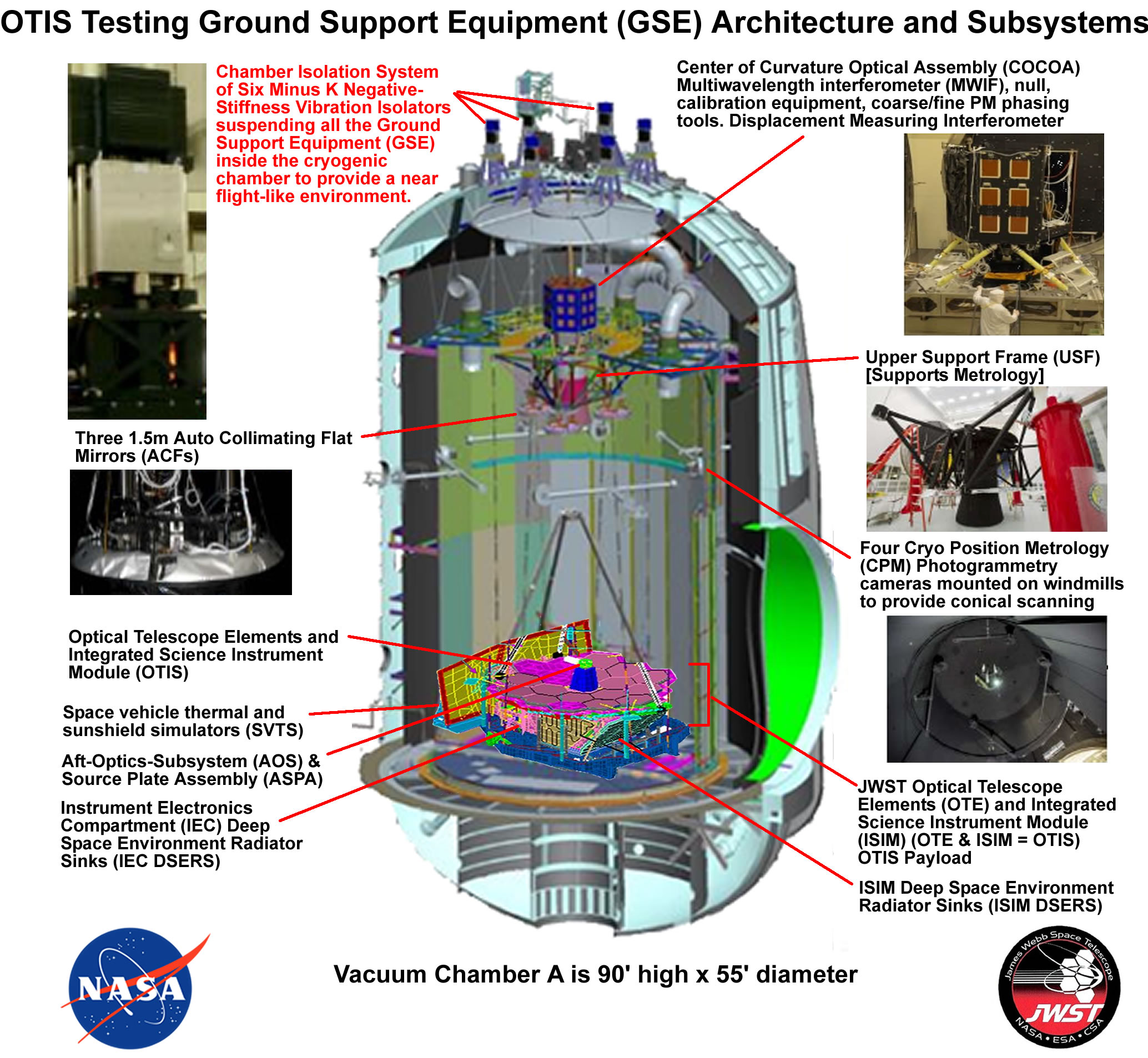
Diagram of the Cyrogenic Chamber in
which the JWST was tested for space.
For three years, NASA JSC engineers built
and remodeled the chambers interior for the temperature needed to test the
James Webb Space Telescope. Chamber A was retrofitted with the helium shroud,
inboard of the existing liquid-nitrogen shroud and is capable of dropping the
chambers temperature farther down than ever, which is 11 degrees above absolute
zero (11 Kelvin, -439.9 Fahrenheit or -262.1 Celsius).
A key addition
to Chamber A was the addition of a set of six custom Minus K
negative-stiffness vibration isolators. The Minus K passive isolators do
not require air and offer better isolation than air and active isolation
systems. A major factor in the selection of the of the vibration isolators was
that they not only isolate vibration vertically, but also horizontally at less
than 1 Hz.
JWST was designed to work in space where the disturbances
are highly controlled and only come from the spacecraft, while on Earth with
all the ground-based disturbances, such as the pumps and motors, and even
traffic driving by can affect the testing. The Minus K vibration isolators
provided dynamic isolation from external vibration sources to create a near
flight-like disturbance environment.
The isolators utilize Minus K's
patented Thermal Responsive Element (TRE) compensator device, a passive
mechanical device, requiring no air or electricity just like the isolators. The
TRE compensator adjusted the isolators as the temperature changes throughout
the testing at JSC, keeping the JWST in the proper position.
The
Critical Design Review for Spacecraft-to-Optical Telescope Element vibration
isolation system was completed one month earlier than scheduled at the end of
2011. The six Minus K negative-stiffness vibration isolators were installed on
top of Johnson Space Centers Thermal Vacuum Chamber A in March
2014.
JWST needed a support structure inside the vacuum chamber to hold
equipment for the testing. Engineers installed a massive steel platform
suspended from the six vibration isolators via steel rods about 60 feet long
(18.2 meters) each and about 1.5 inches (or 38.1 mm) in diameter, to hold the
telescope and key pieces of test equipment. The sophisticated optical telescope
test equipment included an interferometer, auto-collimating flat mirrors, and a
system of photogrammetry precision surveying cameras in precise relative
alignment inside the chamber while isolated from any sources of vibration, such
as the flow of nitrogen and helium inside the shroud plumbing and the rhythmic
pulsing of vacuum pumps.
Minus K's Involvement continued...
-How
much farther can JWST see than the Hubble?
-Why
was it launched from near the equator?
-How
cold does the JWST get in space?
-How
did origami play into the trip?
-Why
24-karat gold on the mirrors?
Full
article...
|
 |
|
NASA Roman
Space Telescope
Vibration Isolation Optimizes Image
Clarity
By Steve
Varma
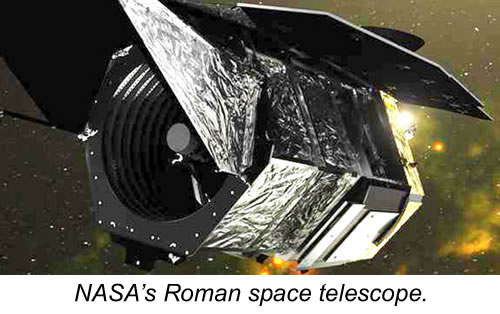
By Steve Varma: The Nancy Grace
Roman Space Telescope (Roman), formerly named the Wide Field Infrared Survey
Telescope (WFIRST), is a NASA space observatory currently in development and is
scheduled to launch into space no later than May 2027.
The Roman Space
Telescope hosts two instruments: the Wide Field Instrument (WFI) which
emphasizes studying the evolution of the universe and understanding what solar
systems beyond our own are like; and the Coronagraph Instrument to advance
technologies for extreme high contrast imaging and spectroscopy from
space.
In 1998, scientists discovered that the expansion of the universe
is accelerating, causing them to reconsider their models for the formation of
the universe. Visible matter accounts for only about five percent of the
contents of the universe.
Nearly 27 percent of the universe comes in the
form of dark matter, which doesnt emit or absorb light. NASAs Roman space
telescope. Dark matter is only detectable through its gravitational effects on
visible matter.
A significant portion of the Romans mission will be
dedicated to monitoring hundreds of thousands of distant galaxies for supernova
explosions, which can be used to study dark energy and the expansion of the
universe.
Romans primary instrument is the Wide Field Instrument (WFI)
which will have a field of view that is 100 times greater than Hubbles widest
exposure. It will capture more of the sky with less observing time. Over the
first five years of observations, Roman will image over 50 times as much sky as
Hubble has covered so far in 30 years. The WFI will measure light from a
billion galaxies over the course of the mission lifetime.
Full
article...
|
|
 |
NASA's ICESat-2 Spacecraft relies with
testing using Minus K vibration isolation
Inside a thermal vacuum chamber. No
electrical cords required.
|
|
NASA’S Ice, Cloud and Land Elevation
Satellite-2 (ICESat-2), which lifted off three years ago, has generated a
comprehensive portrait of the complexities of ice sheet change and insights
into the future of Greenland and Antarctica. The ICESat-2 measurements, when
compared to the measurements taken by the original ICESat from 2003 to 2009,
showed that in Antarctica the ice sheet is getting thicker in parts of the
continent's interior, likely as a result of increased snowfall. But the massive
loss of ice from the continent's margins (due to ocean warming) far outweighs
any small gains in the interior.
|
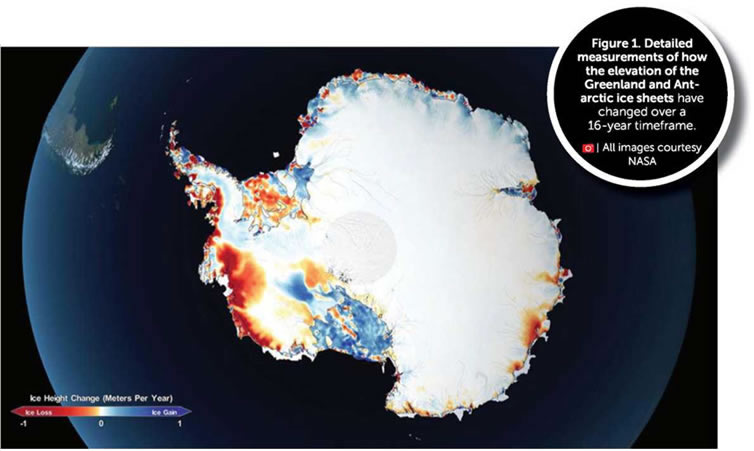
ICESat-2 will measure ice
heights in the polar regions
|
"The new analysis
reveals the ice sheets' response to changes in climate with unprecedented
detail, revealing clues as to why and how the ice sheets are reacting the way
they are," said Alex Gardner, a glaciologist at NASA's Jet Propulsion
Laboratory."
This is one of the first times that researchers have used
laser altimetry to measure loss of the floating ice shelves around Antarctica
simultaneously with loss of the continent's ice sheet. The researchers found
ice shelves are losing mass in West Antarctica, where many of the continent's
fastest-moving glaciers are located. Patterns of thinning over the ice shelves
in West Antarctica show that Thwaites and Crosson ice shelves have thinned the
most, an average of about 16-ft and 10-ft of ice per year,
respectively.
In this technique, AFM tips or sharp needles can be
employed to transfer small, femtoliter volumes of molecular solutions, or other
liquid-based ink, to predefined locations on the surface of
samples.
|
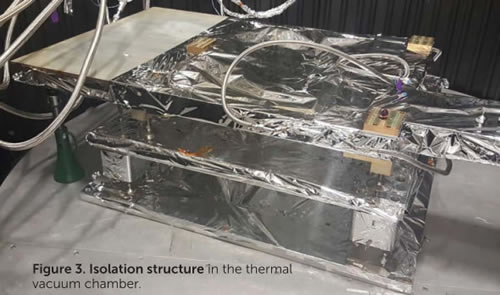
|
The vacuum
chamber was configured with four vacuum compatible Minus K 800CM-1CV
negative-stiffness vibration isolators to support the ATLAS instrument for the
thermal vacuum testing. "The Minus K isolators' primary use was inside the
thermal chambers which did not have as stable of a mounting surface as we would
have liked," said Brian Simpson, mechanical lead for ATLAS testing. "The
isolators were critical in cancelling out jitter introduced into our system by
the facility."
Full article...
|
|
|
 |
|

Ultra-Low
Vibration Lab facilitates
nanoengineering
discoveries
|
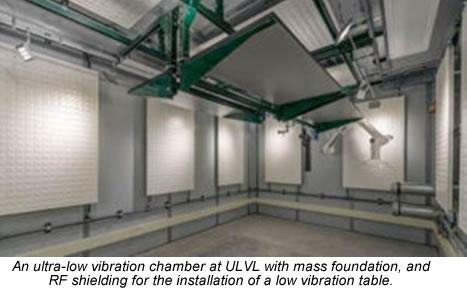
|
The University of Michigan's ultra-low vibration lab
(ULVL) has already accomplished two major scientific milestones since its
opening in 2014: measuring heat fluxes at the nanoscale and establishing that
LEDs can be used to cool electronic devices.
Noel Perkins, former
associate chair for Facilities and Planning with the Department of Mechanical
Engineering, describes this addition as a building-within-a-building. The
Nanoengineering Lab, located on the ground floor, contains eight
ultra-low-vibration chambers for nanoscale metrology, mechanical, temperature
and interference testing.
Supporting these discoveries are ULVL's
negative-stiffness
vibration isolation platforms, designed by Minus K
Technology, which have enabled record low vibration levels in all ULVL chambers
ranging from VC-K to VC-M at frequencies above 2.5 Hz.
The ULVL is a
part of the new Center of Excellence in Nano Mechanical Science and Engineering
(NAMSE) a recent addition to the G.G. Brown Laboratories on the North Campus of
the University of Michigan in Ann Arbor.
Noel Perkins, former Associate
Chair for Facilities and Planning with the Department of Mechanical
Engineering, describes this addition as a "building-within-a-building." The
nanoengineering lab, located on the ground floor, contains eight ultra-low
vibration chambers for nanoscale metrology, mechanical, temperature, and
interference testing.
The chambers are structurally isolated from the
balance of the building. Vibration isolation tables are mounted on pillars that
are part of an 8 ft (2.4m) thick seismic mass, which is isolated from the
chamber floors. Even researchers' footsteps will not disturb
experiments.
"With the emergence of nanotechnology and nanoengineering
of the last two decades, a relatively small number of institutions and agencies
have been able to construct facilities for ultra-sensitive measurements, and I
know of none that are focused on the mission of a mechanical engineering
department," says Edgar Meyhofer, professor of mechanical engineering and
biomedical engineering at the university.
Article
continued...(Including Custom Low-Vibration Chamber, Cooling Supercomputers,
Engineering a Solution for the Lab, Record-Low VC-M
Level)
| |
|
|
|
|
Only 2.7"
High
Announcing
the NEW CT-10
Ultra-Thin Low-Height Tabletop
Vibration Isolation
Platform
|

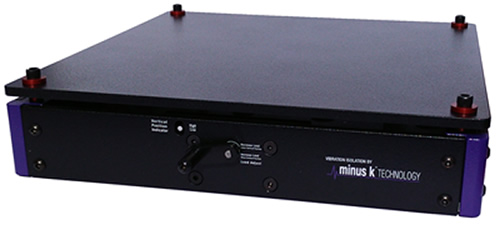
|
The Compact Tabletop
(CT-10)uses
Minus K's patented breakthrough technology allowing for the best performance on
the market in just a 2.7 inch tall; approximately 12.6 inches deep and wide
isolation platform. This unit is as tall as Minus K's CT-2 and offers similar
horizontal performance with additional payload ranges for smaller
instruments..
This completely passive mechanical isolator offers 10-100
times better performance than a full size air table. It does this without any
air or electricity!
This vibration isolation platform is extremely easy
to use and offers our signature 0.5 Hz vertical natural frequency and ~1.5 Hz
horizontal natural frequency. There are only two adjustments. The
CT-10
is ideal for all types of benchtop microscopes
This is the thinnest,
most portable and most user-friendly isolator ever offered that is capable of
delivering this performance.
See
Weight & Pricing Details...
|
|
|
|
|
|

 |
|
|
